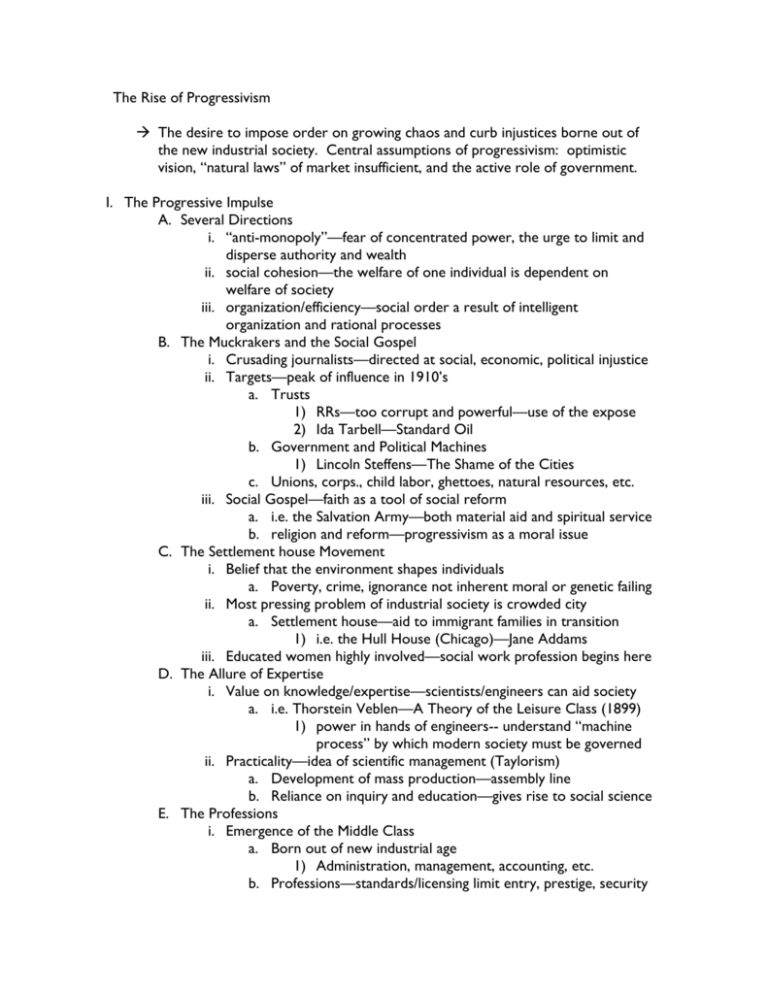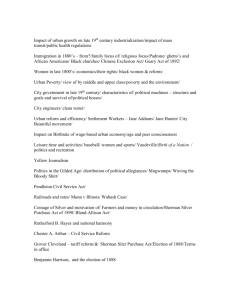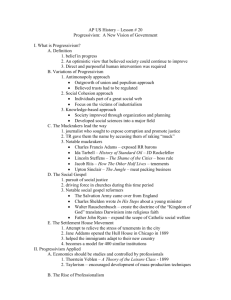Brinkley CH 21
advertisement

The Rise of Progressivism The desire to impose order on growing chaos and curb injustices borne out of the new industrial society. Central assumptions of progressivism: optimistic vision, “natural laws” of market insufficient, and the active role of government. I. The Progressive Impulse A. Several Directions i. “anti-monopoly”—fear of concentrated power, the urge to limit and disperse authority and wealth ii. social cohesion—the welfare of one individual is dependent on welfare of society iii. organization/efficiency—social order a result of intelligent organization and rational processes B. The Muckrakers and the Social Gospel i. Crusading journalists—directed at social, economic, political injustice ii. Targets—peak of influence in 1910’s a. Trusts 1) RRs—too corrupt and powerful—use of the expose 2) Ida Tarbell—Standard Oil b. Government and Political Machines 1) Lincoln Steffens—The Shame of the Cities c. Unions, corps., child labor, ghettoes, natural resources, etc. iii. Social Gospel—faith as a tool of social reform a. i.e. the Salvation Army—both material aid and spiritual service b. religion and reform—progressivism as a moral issue C. The Settlement house Movement i. Belief that the environment shapes individuals a. Poverty, crime, ignorance not inherent moral or genetic failing ii. Most pressing problem of industrial society is crowded city a. Settlement house—aid to immigrant families in transition 1) i.e. the Hull House (Chicago)—Jane Addams iii. Educated women highly involved—social work profession begins here D. The Allure of Expertise i. Value on knowledge/expertise—scientists/engineers can aid society a. i.e. Thorstein Veblen—A Theory of the Leisure Class (1899) 1) power in hands of engineers-- understand “machine process” by which modern society must be governed ii. Practicality—idea of scientific management (Taylorism) a. Development of mass production—assembly line b. Reliance on inquiry and education—gives rise to social science E. The Professions i. Emergence of the Middle Class a. Born out of new industrial age 1) Administration, management, accounting, etc. b. Professions—standards/licensing limit entry, prestige, security 1) i.e. American Medical Association (AMA), 1901 2) Bar associations, business admins., farm bureaus F. Women and the Professions i. “helping” professions a. trend towards social work, teaching, nursing, librarians, etc. II. Women and Reform A. Prominent role of women in reform movements marks Progressivism B. The “New Woman” i. Searching for opportunities outside of the home a. Less children, schooling, income outside of home ii. Increasing number of single women or “Boston Marriages” iii. Higher education—1st generation of academics after rise of colleges C. The Clubwomen i. Clubs serve as outlet for middle to upper class women ii. Increasing shift from cultural activities to social reform a. Support for child labor, workers comp., food/drug laws, etc. b. AfAm women join occasionally, develop own clubs—NACW iii. Clubs not an overt threat to superiority of men—still influential D. Women’s Suffrage i. Largest single reform movement of era a. Radical implications—challenge “sphere” of wives/mothers b. Anti-suffrage in response ii. Better leadership and organization emerges a. i.e. NAWSA—Nat’l American Woman Suffrage Association 1) Anna Howard Shaw—Boston social worker 2) Carrie Chapman Catt—Iowa journalist iii. Less threatening tone a. Virtue would aid politics—maternal instincts, sensitivity, calm b. Wave of states extend suffrage (i.e. WA-1910, CA-1911) c. 19th Amendment (1920)—full suffrage for women III. The Assault on the parties A. As government was the only effective counter to private interests—the system itself would have to be changed in order to facilitate reform B. Early attacks i. Roots in Greenbackism and Populism—challenge to partisanship a. The secret ballot ii. Belief that party rule could be curbed by a. Increasing power of the people b. Increasing power of nonpartisan, unelected officials C. Municipal Reform i. Focus on most damaging structures—city politics a. Attacks on city bosses and special interests 1) Saloon owners, businessmen, immigrant voting power ii. Significant actions taken a. Commissions formed 1) i.e. Galveston, TX—tidal wave exposes govt’s inability a) elected nonpartisan commission formed b) becomes model for many other cities b. City Manager plan—Hiring outside experts to run govt. c. Election reform—i.e. nonpartisan mayors, races moved D. Statehouse Progressivism i. Increasing the power of the electorate a. Initiative—introduce new legislation directly to voters b. Referendum—legislature actions returned to electorate c. Direct primary—selection away from party bosses d. Recall—right to remove a public official ii. Robert La Follette (WI)—most celebrated state reformer a. Approved the increasing power of the electorate b. Regulated RRs, utilities, workplace—corp. taxes E. Parties and interest groups i. Parties’ centrality diminished ii. Rise of interest groups—power to directly influence govt. a. Professional org, trade associations, farm lobbies, etc. b. Also: settlement houses, women’s clubs, etc. IV. Sources of Progressive Reform A. Though middle-class reformers dominate progressivism, not alone in goals B. Labor, the Machine, and Reform i. Labor unions a. i.e. Union Labor Party—committed to reform similar to elite 1) in CA, child labor, worker’s comp., hrs. for women 2) contributes to other states as well ii. Assault on parties lead to fundamental changes within machines a. i.e. Tammany Hall—notorious city machine changes focus 1) conditions, eliminate abuses of industrial economy iii. Triangle Shirtwaist Fire (1911)—146 workers die a. Top three floors ablaze, doors locked to prevent absences b. Management held accountable for fate of workers c. Investigation commission recommends drastic reforms 1) Much support in state legislature 2) Increased regulation and effective enforcement C. The Western Progressives i. Most influential—Hiram Johnson (CA) ii. Focus on reform of the federal government a. i.e. water issues, public land D. African-Americans and Reform i. Progressives gave little attention to questions of race ii. AfAms challenge existing racial norms a. WEB DuBois—demands full education/immediate civil rights b. Niagara Movement (1905) inspires NAACP—equal rights V. Crusades for Order and Reform A. Focus on both political processes and moral issues—alcohol, prost., divorce B. The Temperance Crusade i. Elimination of alcohol necessary to restoration of order in society ii. Problems associated with alcohol a. Women—male reliance creates problems for wives, mothers b. Employers decry missed work, shoddy production c. Political reformers view saloon as function of political machine iii. Resurgence after Civil War a. Women’s Christian Temperance Movement (WTCU), 1873 1) Led by Frances Willard after 1879 2) ¼ million members by 1911—largest women’s group b. Anti-Saloon League (1893) c. Call for abolition of saloons, later for ban on sale/production iv. Steady and growing pressure for complete prohibition a. Before WWI—several states become “dry” b. Moral fervor of WWI provides final push c. 1919—18th Amendment ratified C. Immigration Restriction i. Wide disagreement on how to respond to immigrant “problem” a. Direct help to new Americans vs. limit number of arrivals ii. Growing Nativism marks era a. Fear of “dilution” of racial stock b. “Eugenics”—hereditary improvement by selective breeding c. newer immigrant groups less “assimilable” to U.S. culture d. even most detractors believed immigration should be limited iii. Employers block most restrictions—until mid 1910’s D. The Dream of Socialism i. Radical critiques of capitalist system most popular from 1900-1914 a. i.e. Socialist Party of America—Eugene Debs as leader 1) 1 million votes in 1912 2) urban immigrants AND farmers of south and Midwest ii. Socialists argue for basic structural changes in economy a. Some endorse Marxists—end to capitalism/private property b. Others believe in moderate reform for free enterprise iii. Industrial Workers of the World (IWW), “Wobblies”—100k (1923) a. Radical labor union—advocate single union for all workers b. Call for abolition of class and profit system 1) William “Big Bill” Haywood as leader c. Some use of terror and intimidation iv. Socialist dominated by moderates who advocated peaceful change a. Gradual education of public and patience v. Lack of support for war and rise of anti-radicalism weakens socialists E. Decentralization and Regulation i. Many reformers advocate for changes within capitalist system a. Federal govt. should ensure fair competition 1) Louis Brandeis, lawyer speaks of the “curse of bigness” ii. Other progressives focus on efficiency—differentiate good/bad trusts iii. Oversight by strong, modernized govt. led by executive—TR?






